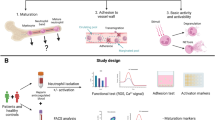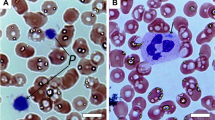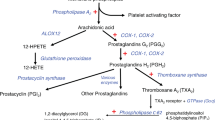Abstract
Integrins are the major adhesion receptors of leukocytes and platelets. β1 and β2 integrin function on leukocytes is crucial for a successful immune response and the platelet integrin αIIbβ3 initiates the process of blood clotting through binding fibrinogen1,2,3. Integrins on circulating cells bind poorly to their ligands but become active after 'inside-out' signaling through other membrane receptors4,5. Subjects with leukocyte adhesion deficiency-1 (LAD-I) do not express β2 integrins because of mutations in the gene specifying the β2 subunit, and they suffer recurrent bacterial infections6,7. Mutations affecting αIIbβ3 integrin cause the bleeding disorder termed Glanzmann's thrombasthenia3. Subjects with LAD-III show symptoms of both LAD-I and Glanzmann's thrombasthenia. Their hematopoietically-derived cells express β1, β2 and β3 integrins, but defective inside-out signaling causes immune deficiency and bleeding problems8. The LAD-III lesion has been attributed to a C → A mutation in the gene encoding calcium and diacylglycerol guanine nucleotide exchange factor (CALDAGGEF1; official symbol RASGRP2) specifying the CALDAG-GEF1 protein9, but we show that this change is not responsible for the LAD-III disorder. Instead, we identify mutations in the KINDLIN3 (official symbol FERMT3) gene specifying the KINDLIN-3 protein as the cause of LAD-III in Maltese and Turkish subjects. Two independent mutations result in decreased KINDLIN3 messenger RNA levels and loss of protein expression. Notably, transfection of the subjects' lymphocytes with KINDLIN3 complementary DNA but not CALDAGGEF1 cDNA reverses the LAD-III defect, restoring integrin-mediated adhesion and migration.
This is a preview of subscription content, access via your institution
Access options
Subscribe to this journal
Receive 12 print issues and online access
$209.00 per year
only $17.42 per issue
Buy this article
- Purchase on Springer Link
- Instant access to full article PDF
Prices may be subject to local taxes which are calculated during checkout




Similar content being viewed by others
References
von Andrian, U.H. & Mempel, T.R. Homing and cellular traffic in lymph nodes. Nat. Rev. Immunol. 3, 867–878 (2003).
Hogg, N., Laschinger, M., Giles, K. & McDowall, A. T-cell integrins: more than just sticking points. J. Cell Sci. 116, 4695–4705 (2003).
Coller, B.S. & Shattil, S.J. The GPIIb/IIIa (integrin αIIbβ3) odyssey: a technology-driven saga of a receptor with twists, turns, and even a bend. Blood 112, 3011–3025 (2008).
Kellermann, S.A., Dell, C.L., Hunt, S.W. III & Shimizu, Y. Genetic analysis of integrin activation in T lymphocytes. Immunol. Rev. 186, 172–188 (2002).
Kinashi, T. Intracellular signalling controlling integrin activation in lymphocytes. Nat. Rev. Immunol. 5, 546–559 (2005).
Anderson, D.C. & Springer, T.A. Leukocyte adhesion deficiency: an inherited defect in the Mac-1, LFA-1, and p150,95 glycoproteins. Annu. Rev. Med. 38, 175–194 (1987).
Hogg, N. & Bates, P.A. Genetic analysis of integrin function in man: LAD-I and other syndromes. Matrix Biol. 19, 211–222 (2000).
Etzioni, A. & Alon, R. Leukocyte adhesion deficiency III: a group of integrin activation defects in hematopoietic lineage cells. Curr. Opin. Allergy Clin. Immunol. 4, 485–490 (2004).
Pasvolsky, R. et al. A LAD-III syndrome is associated with defective expression of the Rap-1 activator CalDAG-GEFI in lymphocytes, neutrophils, and platelets. J. Exp. Med. 204, 1571–1582 (2007).
Kuijpers, T.W. et al. Leukocyte adhesion deficiency type 1 (LAD-I)/variant. A novel immunodeficiency syndrome characterized by dysfunctional β2 integrins. J. Clin. Invest. 100, 1725–1733 (1997).
McDowall, A. et al. A novel form of integrin dysfunction involving β1, β2, and β3 integrins. J. Clin. Invest. 111, 51–60 (2003).
Kuijpers, T.W. et al. Natural history and early diagnosis of LAD-I/variant syndrome. Blood 109, 3529–3537 (2007).
Springett, G.M., Kawasaki, H. & Spriggs, D.R. Non-kinase second-messenger signaling: new pathways with new promise. Bioessays 26, 730–738 (2004).
Stone, J.C. Regulation of Ras in lymphocytes: get a GRP. Biochem. Soc. Trans. 34, 858–861 (2006).
Clyde-Smith, J. et al. Characterization of RasGRP2, a plasma membrane-targeted, dual specificity Ras/Rap exchange factor. J. Biol. Chem. 275, 32260–32267 (2000).
Crittenden, J.R. et al. CalDAG-GEFI integrates signaling for platelet aggregation and thrombus formation. Nat. Med. 10, 982–986 (2004).
Bergmeier, W. et al. Mice lacking the signaling molecule CalDAG-GEFI represent a model for leukocyte adhesion deficiency type III. J. Clin. Invest. 117, 1699–1707 (2007).
Ghandour, H., Cullere, X., Alvarez, A., Luscinskas, F.W. & Mayadas, T.N. Essential role for Rap1 GTPase and its guanine exchange factor CalDAG-GEFI in LFA-1 but not VLA-4 integrin mediated human T-cell adhesion. Blood 110, 3682–3690 (2007).
Cifuni, S.M., Wagner, D.D. & Bergmeier, W. CalDAG-GEFI and protein kinase C represent alternative pathways leading to activation of integrin alphaIIbß3 in platelets. Blood 112, 1696–1703 (2008).
Moser, M., Nieswandt, B., Ussar, S., Pozgajova, M. & Fassler, R. Kindlin-3 is essential for integrin activation and platelet aggregation. Nat. Med. 14, 325–330 (2008).
Moser, M. et al. Kindlin-3 is required for β2 integrin–mediated leukocyte adhesion to endothelial cells. Nat. Med. Advance online publication doi:10.1038/nm.1921 (22 February 2009).
Ussar, S., Wang, H.V., Linder, S., Fassler, R. & Moser, M. The Kindlins: subcellular localization and expression during murine development. Exp. Cell Res. 312, 3142–3151 (2006).
Larjava, H., Plow, E.F. & Wu, C. Kindlins: essential regulators of integrin signalling and cell-matrix adhesion. EMBO Rep. 9, 1203–1208 (2008).
Siegel, D.H. et al. Loss of kindlin-1, a human homolog of the Caenorhabditis elegans actin-extracellular-matrix linker protein UNC-112, causes Kindler syndrome. Am. J. Hum. Genet. 73, 174–187 (2003).
Jobard, F. et al. Identification of mutations in a new gene encoding a FERM family protein with a pleckstrin homology domain in Kindler syndrome. Hum. Mol. Genet. 12, 925–935 (2003).
Garcia-Alvarez, B. et al. Structural determinants of integrin recognition by talin. Mol. Cell. 11, 49–58 (2003).
Weinstein, E.J. et al. URP1: a member of a novel family of PH and FERM domain-containing membrane-associated proteins is significantly over-expressed in lung and colon carcinomas. Biochim. Biophys. Acta. 1637, 207–216 (2003).
Kloeker, S. et al. The Kindler syndrome protein is regulated by transforming growth factor-β and involved in integrin-mediated adhesion. J. Biol. Chem. 279, 6824–6833 (2004).
Montanez, E. et al. Kindlin-2 controls bidirectional signaling of integrins. Genes Dev. 22, 1325–1330 (2008).
Ma, Y.Q., Qin, J., Wu, C. & Plow, E.F. Kindlin-2 (Mig-2): a co-activator of β3 integrins. J. Cell Biol. 181, 439–446 (2008).
Mory, A. et al. Kindlin-3: a new gene involved in the pathogenesis of LAD-III. Blood 112, 2591 (2008).
Campbell, I.D. & Ginsberg, M.H. The talin-tail interaction places integrin activation on FERM ground. Trends Biochem. Sci. 29, 429–435 (2004).
Calderwood, D.A. et al. The phosphotyrosine binding-like domain of talin activates integrins. J. Biol. Chem. 277, 21749–21758 (2002).
Harris, E.S. et al. A novel syndrome of variant leukocyte adhesion deficiency involving defects in adhesion mediated by β1 and β2 integrins. Blood 97, 767–776 (2001).
Alon, R. et al. A novel genetic leukocyte adhesion deficiency in subsecond triggering of integrin avidity by endothelial chemokines results in impaired leukocyte arrest on vascular endothelium under shear flow. Blood 101, 4437–4445 (2003).
Smith, A. et al. A talin-dependent LFA-1 focal zone is formed by rapidly migrating T lymphocytes. J. Cell Biol. 170, 141–151 (2005).
Acknowledgements
We are indebted to R. Fässler and D. Wagner for helpful discussion; J. Crittenden and A. Graybiel (Massachusetts Institute of Technology) for antibodies to CALDAG-GEF1, cDNA constructs and helpful discussion; and J. Hancock (University of Queensland Medical School) for CALDAGGEF1 constructs. We are also grateful to our Cancer Research UK London Research Institute colleagues D. Harvey for generation of the EBV-transformed cell lines and G. Kelly for help with the statistical analyses. L. S. was supported by a Marie Curie Individual Fellowship.
Author information
Authors and Affiliations
Contributions
L.S., K.H., I.T., M.F. and N.H. designed the experiments; L.S., K.H., A.M., I.P. and R.E. performed the experiments; and A.M. provided subject blood samples; S.U. provided the antibody to Kindlin-3; M.M. provided the EGFP–Kindlin-3 construct;. L.S., K.H., A.M., I.P., M.F., I.T. and N.H. were involved in data analyses. All authors contributed to the writing or editing of the manuscript. N.H. supervised the project and wrote the initial manuscript.
Corresponding author
Supplementary information
Supplementary Text and Figures
Supplementary Figs. 1–5 and Supplementary Methods (PDF 5122 kb)
Supplementary Video 1
GFP-expressing LAD-III B cells (Turkish family three) migrating on ICAM-1. (MOV 7433 kb)
Supplementary Video 2
CALDAG-GEF-1–expressing LAD-III B cells (Turkish family three) migrating on ICAM-1. (MOV 4545 kb)
Supplementary Video 3
Kindlin-3–expressing LAD-III B cells (Turkish family three) migrating on ICAM-1. (MOV 8949 kb)
Supplementary Video 4
Kindlin-3–expressing LAD-III B cells (Turkish family three) migrating on ICAM-1. (MOV 9724 kb)
Rights and permissions
About this article
Cite this article
Svensson, L., Howarth, K., McDowall, A. et al. Leukocyte adhesion deficiency-III is caused by mutations in KINDLIN3 affecting integrin activation. Nat Med 15, 306–312 (2009). https://doi.org/10.1038/nm.1931
Received:
Accepted:
Published:
Issue Date:
DOI: https://doi.org/10.1038/nm.1931
This article is cited by
-
Inactivation of kindlin-3 increases human melanoma aggressiveness through the collagen-activated tyrosine kinase receptor DDR1
Oncogene (2024)
-
Whole-genome screens reveal regulators of differentiation state and context-dependent migration in human neutrophils
Nature Communications (2023)
-
A Novel Deletion in FERMT3 Causes LAD-III in a Turkish Family
Journal of Clinical Immunology (2023)
-
FERMT1 contributes to the migration and invasion of nasopharyngeal carcinoma through epithelial–mesenchymal transition and cell cycle arrest
Cancer Cell International (2022)
-
Kindlin-2 loss in condylar chondrocytes causes spontaneous osteoarthritic lesions in the temporomandibular joint in mice
International Journal of Oral Science (2022)



